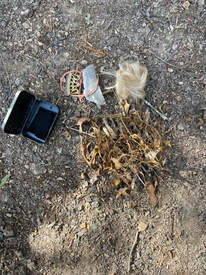 Charcloth, Viking Age fire striker (I have a more medieval one on the way), flint, flax and random leaves and sticks that I tried to use to start the fire.
Charcloth, Viking Age fire striker (I have a more medieval one on the way), flint, flax and random leaves and sticks that I tried to use to start the fire. For the SCA Foresters' Guild there are requirements to progress from one rank to the next. Æthelmearc currently is falling under the East Kingdom and the Checklist, as well as other pertinent documents with rules and regulations, can be found HERE.
Once you swear the Forester's oath, you can work towards different goals within the guild. This is one thing I love about some of the guilds within the SCA. They give you tangible goals, AND have people willing to jump in and help you along the way. (Another great guild with goals is the Company of the Silver Spindle in Atlantia.
I took the Oath at Pennsic and now am starting on working towards Underforester. For this you need to start a fire, cook a meal for one, have some green garb and participate in camping (yes, Pennsic camping counts). Most of my garb is green, but the Forester kit I am building out has that goal in mind. Currently I have green chausses and hood, along with a brown wool and blue linen tunic. Eventually I will have a green wool and a green linen tunic as well. I have cloth for two green cloaks as well, I just need to get them cut out.
The next rank is Forester. For this you need period gear and equipment (working on it). Period shoes (have them). Full forester garb (technically have that except that cloak that needs cut out, BUT I want to revise the garb I made this year already). You need to be helpful and cook for a group over a fire. And you need to start a fire with a period method. I have done this in the past several times with flint and steel, but my technique is, um, rusty. I also started a fire with charcloth and a magnifying glass at the Shire Day in the Park this past June. I tried to do it today, and got the charcloth to catch and started to get my nest going but the flax that I was using as the base of the nest was not catching. Like, it was REALLY, not catching. It came from a very damp room and I think that it might have taken on moisture? I used this same flax years ago with no issues but it honestly did not want to take right away even with a lighter (which I ended up using just to keep things moving.
Once you swear the Forester's oath, you can work towards different goals within the guild. This is one thing I love about some of the guilds within the SCA. They give you tangible goals, AND have people willing to jump in and help you along the way. (Another great guild with goals is the Company of the Silver Spindle in Atlantia.
I took the Oath at Pennsic and now am starting on working towards Underforester. For this you need to start a fire, cook a meal for one, have some green garb and participate in camping (yes, Pennsic camping counts). Most of my garb is green, but the Forester kit I am building out has that goal in mind. Currently I have green chausses and hood, along with a brown wool and blue linen tunic. Eventually I will have a green wool and a green linen tunic as well. I have cloth for two green cloaks as well, I just need to get them cut out.
The next rank is Forester. For this you need period gear and equipment (working on it). Period shoes (have them). Full forester garb (technically have that except that cloak that needs cut out, BUT I want to revise the garb I made this year already). You need to be helpful and cook for a group over a fire. And you need to start a fire with a period method. I have done this in the past several times with flint and steel, but my technique is, um, rusty. I also started a fire with charcloth and a magnifying glass at the Shire Day in the Park this past June. I tried to do it today, and got the charcloth to catch and started to get my nest going but the flax that I was using as the base of the nest was not catching. Like, it was REALLY, not catching. It came from a very damp room and I think that it might have taken on moisture? I used this same flax years ago with no issues but it honestly did not want to take right away even with a lighter (which I ended up using just to keep things moving.
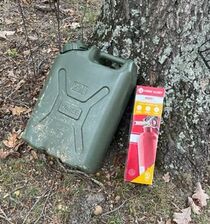
So, enough about what went wrong, lets talk about what went right! I had a great time. I chose a semi-flat spot near a fallen tree in an area where there is no grass or other growth to worry about burning. I also opted for Safety First and had a can of water and a fire extinguisher stashed nearby. We live in the woods, it is autumn so leaves are falling, and we have not had rain in several days. I also used some stones to build a small firebreak on the downhill side from where I was working.
You can see my staged area below, as well as the stages of my fire. I had wood ready, and yes, I did use a few sticks of fatwood. I currently do not have period cooking pots, but did use a small dutchoven, griddle and a little clay vessel I made myself (it is actually a pinch pot for early Celtic stuff, but it is what I have). I have two trivets from Rabenwald Metalsmything but only needed the shorter one for this project. I used a tent stake for lifting the pot around and removing and replacing the lid.
You can see my staged area below, as well as the stages of my fire. I had wood ready, and yes, I did use a few sticks of fatwood. I currently do not have period cooking pots, but did use a small dutchoven, griddle and a little clay vessel I made myself (it is actually a pinch pot for early Celtic stuff, but it is what I have). I have two trivets from Rabenwald Metalsmything but only needed the shorter one for this project. I used a tent stake for lifting the pot around and removing and replacing the lid.
So, what was I going to make? I wanted to do more than just make random food to fill a checklist. I wanted something period appropriate to my persona. So, my assumption here is that I would actually be traveling from London where my persona's uncle lives, back to his own home in York, and realistically, I was not traveling alone as that was very much asking for trouble. We would have more than bare minimum gear with us.
So my personal checklist is:
- Period food items for my persona
- At least somewhat period methods of cooking/compiling them
- Ingredients that would be in season at the same time
In the end I opted for a:
- Dish of parsnips and onions
- Apples with cinnamon and honey
- Flat breads (rye and oat)
- Cheese (for this I opted for Brie that I had at home already)
- I choose to go vegetarian for this as, in additional to Lenten Fridays, there were many days during the 14th Century in England where meat was not allowed
My foodstuffs can be seen below. Most of these vessels are NOT period to my persona, and while some are close (the glass containers), I would not be slinging those around during travel. I would also definitely not be traveling with two heavy mortar and pestle sets, but I needed to grind the cinnamon for the apples so took them outside to work on while the fire was reducing to coals.
While the fire was making coals for me, I went ahead and started the onions in the pot with butter. This is a modern sweet onion as I have serious sensitivity to onion and do not react to this type IF it is cooked until completely dead. I also have some apple and butter in the earthenware pot. I have not fire tested my own pottery yet, so did not want to sit this directly in a bed of coals at this time.
When my onions cooked down some, I added the chopped parsnips and continued to cook those close to the fire, stirring often. When the fire died down enough, I moved the Dutch Oven to sit directly over coals.
Once the parsnips started to soften a little and the onions were VERY cooked, I added white wine, water and a bit of salt.
When my onions cooked down some, I added the chopped parsnips and continued to cook those close to the fire, stirring often. When the fire died down enough, I moved the Dutch Oven to sit directly over coals.
Once the parsnips started to soften a little and the onions were VERY cooked, I added white wine, water and a bit of salt.
While this was cooking I mixed up a little olive oil into the rye and oat flour with a touch of salt and a small amount of honey. I formed these into little patties and put them on the griddle that I had preheated with butter. For the griddle I am using the low trivet and it is placed directly over coals.
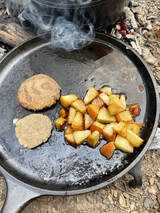
Did I mention the apples were taking forever? I was not quite ready to explode my drinking cup with high heat, so I ended up finishing the apples on the griddle with the flat breads.
Before dumping them from the cup onto the griddle I stirred in a bit of the cinnamon I ground. Part of my research on medieval apothecary revealed that the cinnamon sold in the US is typically cassia, a similar plant, but not true cinnamon. I do, however, keep celyon cinnamon sticks in the house as I have a friend who is allergic to cassia, and I ground one of those for this project.
Before dumping them from the cup onto the griddle I stirred in a bit of the cinnamon I ground. Part of my research on medieval apothecary revealed that the cinnamon sold in the US is typically cassia, a similar plant, but not true cinnamon. I do, however, keep celyon cinnamon sticks in the house as I have a friend who is allergic to cassia, and I ground one of those for this project.
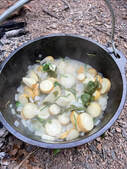
To finish off my main course, I added the foraged sorrel as well as the harvested chives and parsley to the pot, along with a little more water and wine. Then I did a very period thing and thickened the whole thing with bread crumbs (from old bread that I foraged in my kitchen). I believe that bread, a staple of the medieval diet, could easily be bought in towns we would pass through, and eventually one might have an older hunk not really suitable for a meal, even while traveling.
The photo to the right shows the veggie dish right before I added the lid and set the whole thing over coals to finish it off.
The photo to the right shows the veggie dish right before I added the lid and set the whole thing over coals to finish it off.
So how was it all?
Honestly? It was excellent. I forgot to add the honey to the apples so drizzled it on at the end. (My persona, as an apothecary, would have ready access to both honey and several types of sugar, so sweetening a dish is not unreasonable.)
The parsnips and onions were quite savory and had an almost lemony twang with the addition of the sorrel (locally called "sour grass"). The bread crumbs thickened the broth so that it clung to the vegetables making it more "main course" to me than it would have as a soup.
The flat breads were good, but a bit crumbly. They might be made better with a different source of fat (butter, tallow or lard), which is something I can experiment with later. I went with the olive oil because I had it handy here.
Honestly? It was excellent. I forgot to add the honey to the apples so drizzled it on at the end. (My persona, as an apothecary, would have ready access to both honey and several types of sugar, so sweetening a dish is not unreasonable.)
The parsnips and onions were quite savory and had an almost lemony twang with the addition of the sorrel (locally called "sour grass"). The bread crumbs thickened the broth so that it clung to the vegetables making it more "main course" to me than it would have as a soup.
The flat breads were good, but a bit crumbly. They might be made better with a different source of fat (butter, tallow or lard), which is something I can experiment with later. I went with the olive oil because I had it handy here.
And yes, I had help from local wildlife with my meal prep and with helping eat the rind from the Brie!
Also, I did this in garb!
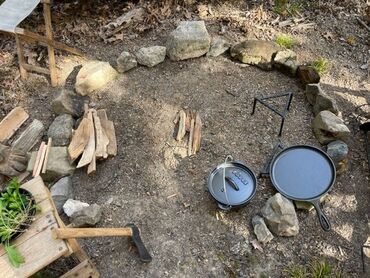
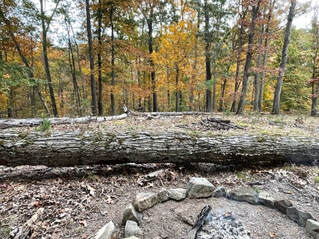
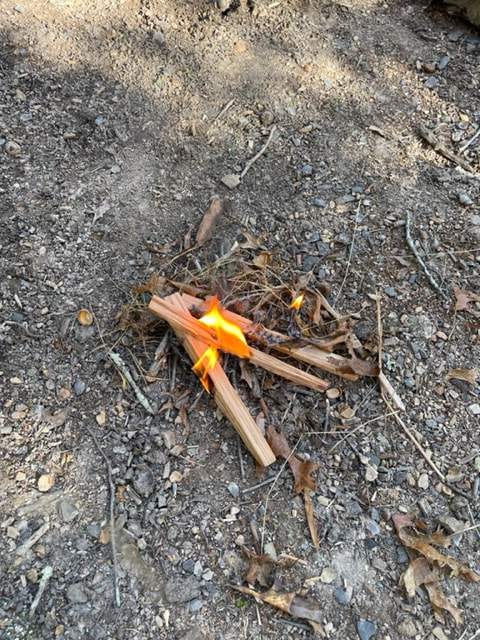
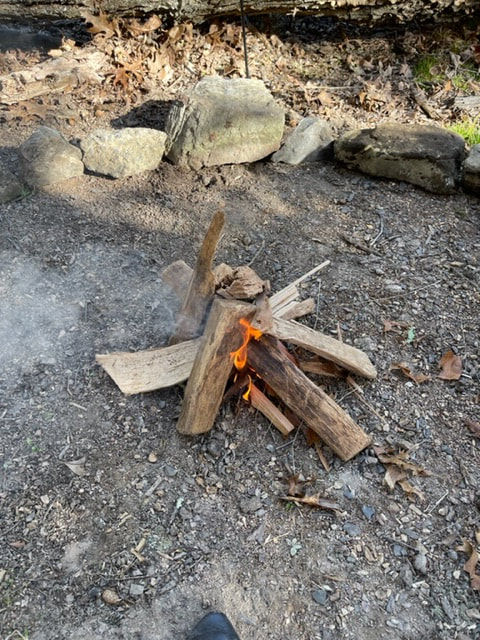
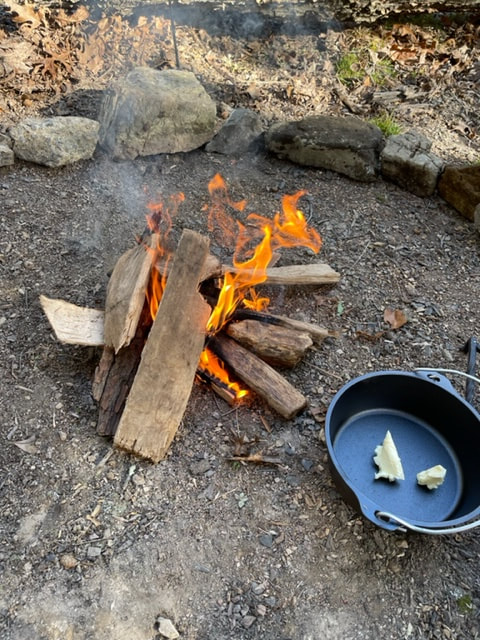
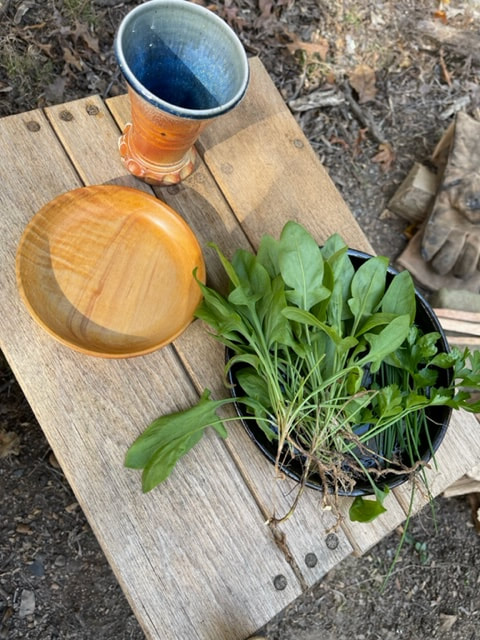
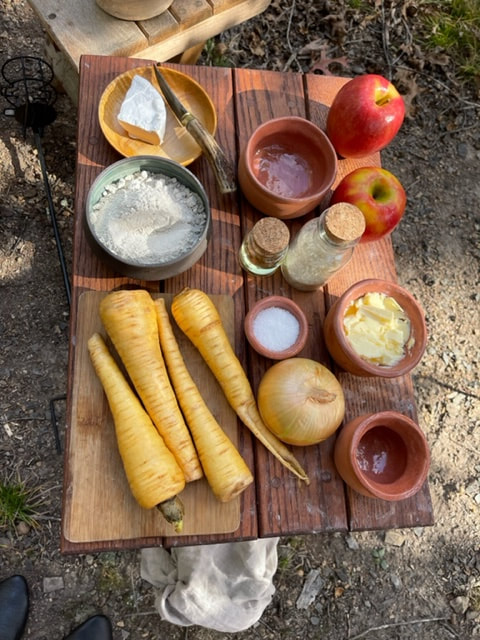
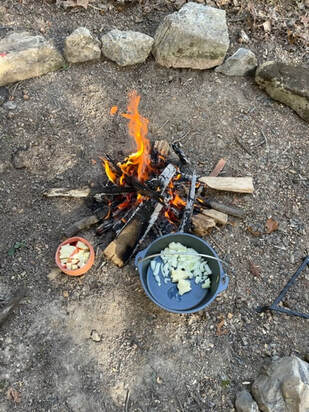
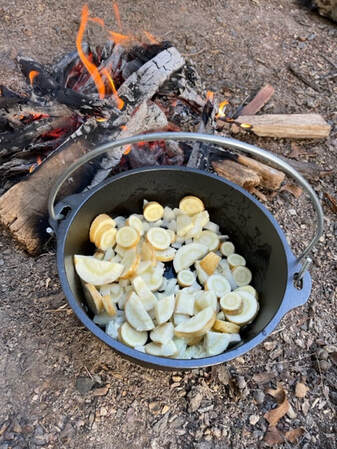
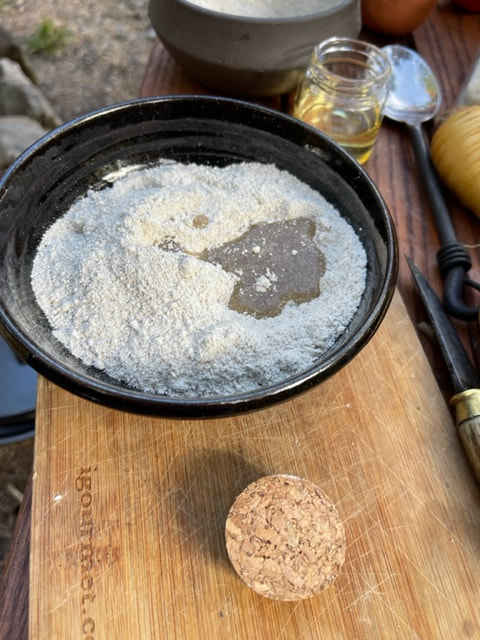
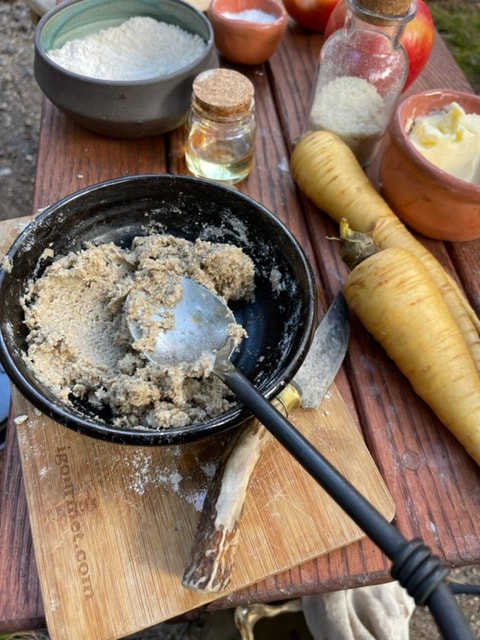
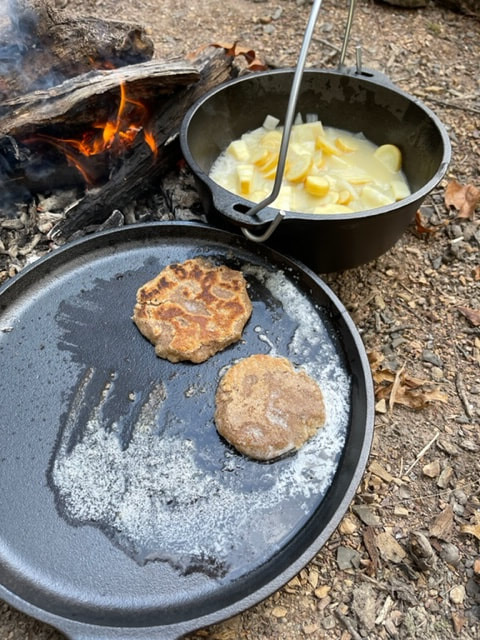
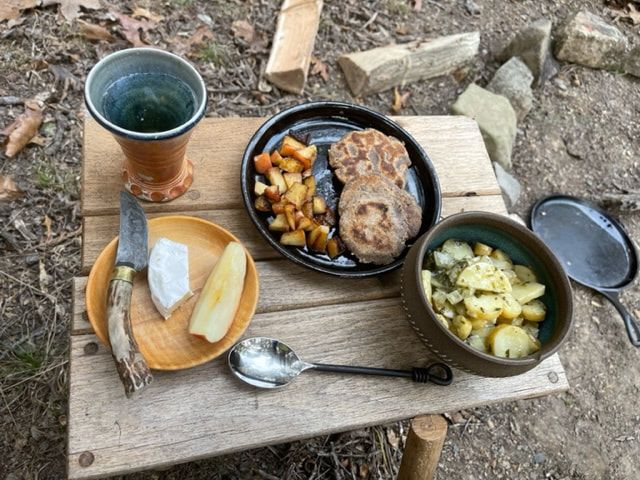
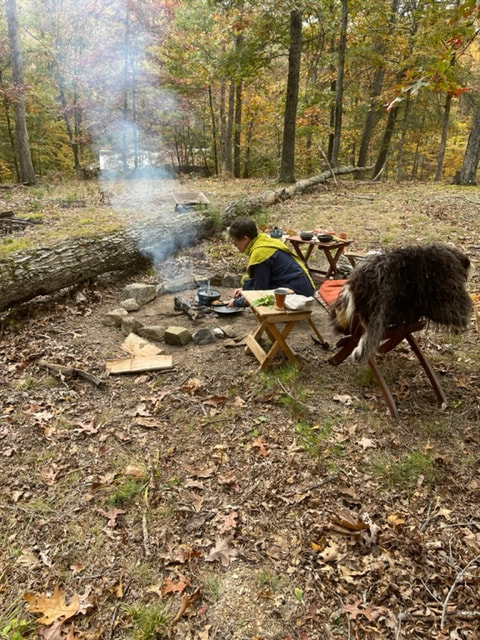
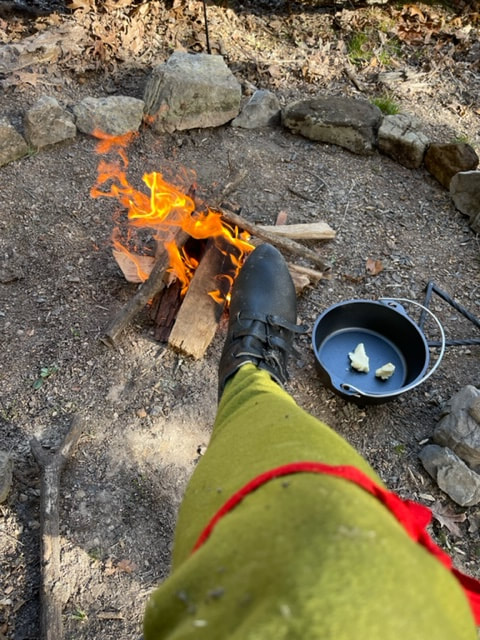
 RSS Feed
RSS Feed